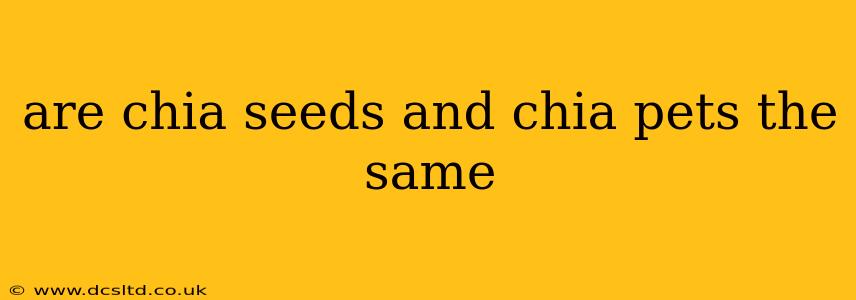The question, "Are chia seeds and Chia Pets the same?" is surprisingly common, sparking curiosity about the connection (or lack thereof) between the tiny, nutrient-packed seeds and the quirky, clay figurines. The short answer is: no, they are not the same. While both share the name "chia," their relationship is purely etymological – they both derive their name from the Salvia hispanica plant. Let's delve deeper into the differences.
What are Chia Seeds?
Chia seeds are tiny, oval-shaped seeds from the Salvia hispanica plant, a flowering herb in the mint family. Originating in Central America, these seeds have been a dietary staple for centuries, revered for their nutritional value. They are a powerhouse of nutrients, boasting impressive amounts of fiber, omega-3 fatty acids, antioxidants, and various minerals. Chia seeds are highly versatile, often added to smoothies, yogurt, baked goods, or even sprinkled on salads. Their ability to absorb liquids and form a gel-like consistency also makes them a popular ingredient in puddings and jams.
What are Chia Pets?
Chia Pets are novelty terracotta figurines that are grown with chia seeds. The figurines are sculpted into various shapes – animals, cartoon characters, or even household objects. The seeds are applied to the moist surface of the figurine, and with regular watering, they sprout, creating a "hairy" green covering that resembles a miniature landscape. The process is primarily for entertainment and decorative purposes, not for consumption.
Are Chia Seeds Edible from a Chia Pet?
No, chia seeds grown on a Chia Pet are not recommended for consumption. While they are technically chia seeds, the process of growing them on a Chia Pet involves potentially using non-organic soil, exposing the seeds to environmental contaminants, and lacking the rigorous cleaning and quality control measures associated with food-grade chia seeds purchased from stores. Consuming seeds from a Chia Pet could pose health risks.
What are the potential risks of consuming chia seeds from a Chia Pet?
Several factors contribute to the potential health risks. These include:
- Contamination: The soil used in Chia Pets might contain harmful bacteria, pesticides, or other contaminants that could make the seeds unsafe for consumption.
- Cleaning and Processing: Food-grade chia seeds undergo thorough cleaning and processing to ensure they are free of contaminants and suitable for consumption. Chia seeds on a Chia Pet do not undergo this process.
- Handling: Chia Pets are primarily decorative items, not food products. The potential for handling the figurines and contaminating the chia seeds further increases health risks.
What are the benefits of consuming chia seeds (from a reputable source)?
Unlike chia seeds grown on a Chia Pet, commercially produced chia seeds offer a wide array of health benefits, including:
- High in Fiber: Supports healthy digestion and can help regulate blood sugar levels.
- Rich in Omega-3 Fatty Acids: Essential for heart health and brain function.
- Excellent Source of Antioxidants: Protects cells from damage and reduces inflammation.
- Good Source of Protein and Minerals: Contributes to overall health and well-being.
In conclusion, while both chia seeds and Chia Pets derive their name from the same plant, they are distinct and serve entirely different purposes. One is a nutritional powerhouse, while the other is a decorative novelty. Never consume chia seeds grown on a Chia Pet. Stick to purchasing chia seeds from reliable food sources to reap their numerous health benefits.
